By Drs. Gil Fried, Salih Kocak, and Aneurin Grant — University of West Florida
Imagine going to the ballpark to watch your favorite team or attending a concert at a large arena to dance to your favorite band. Most fans would not think twice about their safety when they are in the nosebleed seat. The view from high up can be great. Even with a few beers in your system, you feel safe. Nothing can go wrong up there.
The reality is significantly different. There have been too many examples of people being seriously injured or dying when falling over a railing, falling down ramps, jumping onto handrails and falling off, and other similar injuries venue designers, builders, and operators need to consider. Even if a venue meets the minimum building code requirements, is that enough or appropriate with the knowledge we have concerning how a building is used and how people might need to be protected from their own possible actions or the actions of others?
This article examines some of the more serious injury/death examples over the past twenty years. Various building codes will be discussed. Then, specific guidance is given to those who are designing, building, and operating stadiums and arenas to help create as safe an environment as possible.
History of Railing Dangers
Often, the only thing between fans in the upper deck and the action below is a railing, steel tubing sometimes at 26 inches high. A fan can stand up to cheer, similar to everyone else, the excitement and jostling by others can cause the person to lose their balance. The next thing everyone knows the fan has fallen over the railing seriously injuring herself.
From 1969 to 2011, there were 22 fall-related fatalities at major league ballparks, according to the “Death at the Ballpark” blog compiled by authors David Weeks and Robert Gorman, who published a book by the same name in 2012. Those numbers include all types of fatalities, including suicides and fans who were intoxicated or engaged in risky behavior.
Three deaths over the past 15 years were reported in an ESPN story. One death at Coors Field in Denver happened in May 2011, one at Turner Field in Atlanta in May 2008, and one at Shea Stadium in New York in April 2008. Each of these cases entailed men falling while trying to slide down a staircase or escalator railings. Shockingly enough (note the sarcasm) alcohol was often a factor in these types of incidents.
On the first day, the Texas Rangers’ stadium (called “The Ballpark in Arlington” until the Rangers moved to Globe Life Park in Arlington in 2019) was opened in 1994, Hollye Minter fell backward over a 30-inch railing while posing for a picture. Hollye Minter fell approximately 35’ onto an empty row of chairs below. Minter suffered two fractured vertebrae, two broken ribs, six broken teeth, and other injuries. Shortly after Minter’s fall, the Rangers raised the railings in the section where she fell to 46 inches.
One of the most publicized railing death cases happened the following year in the same ballpark, in Arlington. On July 7, 2011, thirty-nine-year-old Shannon Stone fell to his death over a 33-inch rail. The Rangers determined after that incident that their existing rail heights were inadequate, so they raised the railing height to 46 inches all over the park in preparation for the next season at a cost of $1.1 million.
There have been more injuries and deaths since the Stone tragedy. In 2014, a toddler was hospitalized after tumbling over a railing at the American Airlines Center in Dallas during a performance by the Ringling Brothers Barnum and Bailey Circus.
In 2016, a man was injured after falling over a railing at Oracle Arena following a 2016 NBA Finals game between the Golden State Warriors and the Cleveland Cavaliers. According to the police, the fan was involved in an altercation with another person before the fall.
In 2021 there were several major incidents with the most publicized incident being a mother and toddler who died when they fell over a railing in a picnic bench area at Petco Park in San Diego. Prior to the fall, the mother had a close call while jumping on a picnic table bench, with her young son, near the ledge of an upper concourse. For some reason, the mother and child started jumping on the table a second time, and that is when they fell to their deaths.
Bleacher and grandstand injuries are not unique. The United States Consumer Products Safety Commission (CPSC) issued Guidelines for Retrofitting Bleachers in 2000. The guide highlighted that there was an annual average of 19,100 bleacher-associated injuries treated in emergency rooms (ER). Data from 1999 alone showed 22,100 bleacher-associated injuries treated in hospitals. Approximately 6,100 of these injuries were a result of the person falling from, or through, bleachers, onto the surface below. One recommendation from the CPSC was that the top surface of a bleacher’s guardrail should be at least 42 inches above the leading edge of the footboard, seatboard, or aisle, whichever is adjacent to the guardrail. The CPSC’s 42-inch rail height recommendation was intended to prevent inadvertent falls over the railings by all but the tallest 1% of adults. It further reflected a consensus from different organizations that advocated for a 42-inch-high guardrail such as:
- 2000 National Fire Protection Association (NFPA) 101 Life Safety Code
- 2000 International Building Code (IBC) of the International Code Council (ICC)
- 1999 National Building Code (NBC) of the Building Officials and Code Administrators (BOCA)
- 1997 Uniform Building Code (UBC) of the International Conference of Building Officials (ICBO)
- 1997 Standard Building Code (SBC) of the Southern Building Code Congress International (SBCCI).
Besides falling over or in between railing, railings can collapse. One such example happened at a Major League Soccer match at RFK Stadium in Washington, DC. Amid the post victory championship celebration, about 50 fans were injured when railings on the stadium’s north side collapsed. A similar incident happened in 2022, when a section of railing gave way as Philadelphia Eagles quarterback Jalen Hurts was leaving the field. Luckily no fans were seriously injured in the designated ADA seating area when fans pressed against the railing to contact the quarterback.
These various incidents raise the prospect of liability as injured fans can sue claiming the railing was ineffective or insufficient. Besides possible notice concerning the railing, every college and professional sports team knows that fans reach for foul balls, stand up to go to the concession stand, cheer their team, yell at the other team, stand as a result of prompts during the game, get up to do the “wave,” stand for the national anthem, stand for the 7th inning stretch, and now are constantly being distracted by mascots or Wi-Fi obsessed behavior. Further, it is well known that fans come in all different conditions, with possible medical, psychological, or other conditions or they might be having fun or are intoxicated which could impact their balance and decision making. This begs the questions: why are the requirements for guardrails not more stringent? Should guardrails be higher at ballparks and concert venues where fans regularly engage in “atypical” behaviors and movements? Should guardrails be stronger to accommodate the weight of multiple fans leaning over at the same time? These questions move railing issues from liability issues to focusing on building codes and construction strategies.
Why 26-inches?
The 26-inch minimum height for front-row railings dates to 1929 when it was included in the National Fire Protection Association Building Exits Code. The guide set building safety standards for numerous building types and was a one size fits all approach. The code was not developed specifically for sport or entertainment venues. The code was developed specifically in response to fire hazards rather than spectator crowd issues. The code was created in response to the Triangle Shirtwaist Factory fire which killed 146 people during a 1911 fire in New York City. Over the years, the code has grown to cover numerous issues and concerns associated with a wide range of venues.
It is assumed that the original code developers likely set the standard at a height where railings would not impede someone’s view, and that it was designed mainly for theaters and symphony halls – rather than ballparks and arenas. While 26 inches meets what the code requires, some feel that height is too low, especially attorneys representing injured individuals.
Even with some anecdotal information and opinions, MLB stadiums’ average railing heights around 2010 were closer to 26 inches. The ESPN show “Outside the Lines” contacted officials with all 30 Major League Baseball ballparks in 2011 to examine the heights of their front-row railings at these stadiums. Only 10 teams responded with actual measurements and the measurements ranged from 26 to 36 inches. As previously mentioned, the 26-inch height is the minimum allowed by the IBC and some local building codes.
In the Texas Ranger stadium fall involving Mr. Stone, he measured 6 feet, 3 inches tall, and fell over a 33-inch railing. The railing came up to just below Stone’s belt buckle. A 42-inch railing would have rested just above Stone’s hips. For most people, a 42-inch railing would reach around one’s stomach and would be even higher for shorter people.
The Science of Railing Height
One of the methods to help make the calculation more appropriate is through science. In terms of railing height, that analysis can focus on two key elements. One is the center of gravity, and the other is how people interact with the railing and other venue elements.
The center of gravity represents when and how someone might fall over a railing. Taller people have a higher center of gravity which means that a low railing is more dangerous for a tall person compared with a shorter person whose center of gravity is closer to the 26-inch railing height. Thus, a shorter person is less likely to fall over a 26-inch railing. As stated by Richard Brauer in Safety and Health for Engineers 3rd Edition (2016): “Therefore, if 99% of the population is less than 6 ft 6 in. tall, a 42 in. high top rail will prevent rotation over the rail for all but very few people. Using this estimating method, a 45 in. railing would protect people who are 7 feet tall (p. 128).
According to the International Building Code (IBC 2021), which is used as the basis of most State Building Codes nationwide, guardrail requirements are dependent on the building’s occupancy. Since this article is focused on sport and concert venues, the requirements for guardrails are dependent on several types of Assembly occupancy, as follows:
- Group A-1 – Theaters
- Group A-3 – Exhibition halls
- Group A-4 – Arenas
- Group A-5 – Bleachers, grandstands, and stadiums
The IBC states that guardrail systems are required “along open-sided walking surfaces, including mezzanines, equipment platforms, aisles, stairs, ramps, and landings that are located more than 30 inches (762 mm) measured vertically to the floor or grade below at any point within 36 inches 914 mm) horizontally to the edge of the open side.” (IBC 2021). Further, “required guards shall not be less than 42 inches (1067 mm) high. (IBC 2021).
However, the IBC provides exceptions to the 42” minimum height requirements for “sightline-constrained guard heights”, and reads as follows:
Unless subject to the requirements of Section 1030.17.4, a fascia or railing system in accordance with the guard requirements of Section 1015 and having a minimum height of 26 inches (660 mm) shall be provided where the floor or foot-board elevation is more than 30 inches (762 mm) above the floor or grade below and the fascia or railing would otherwise interfere with the sightlines of immediately adjacent seating.
The 26-inch railing height exemption is unique to the United States. The Sports Ground Safety Authority (SGSA), based in the United Kingdom, publishes the Guide to Safety at Sports Grounds, which is informally referred to as the Green Guide. The standard requires a minimum guard height of 31.5” (800 mm) for sightline-constrained guard heights.
The IBC also discuss how much weight/pressure railings need to withstand to keep people safe, i.e. a “linear load of 50 pounds per linear foot (plf) (0.73kN/m), and a concentrated load of 200 pounds (0.89 kN) (IBC 2021). As with all Building Codes, these are minimum standards.
Provided that the structural requirements for linear and concentrated loads are met, engineers have a fair amount of discretion as to the ultimate design, including the specified materials, size of components, and the manner in which the guardrail is anchored to the structure. In the interests of maintenance and durability, steel and concrete are obvious choices.
The All-Important Top Rail
The usefulness of the guardrails to prevent falling over is directly related to the height of the top rail. The height of guardrails is based on the center of gravity of human beings. Gravity can simply be defined as the downward force that the earth exerts while the center of gravity of the body is the location where the mass of a body is concentrated. The center of gravity of humans is typically located in front of the sacrum which is situated between the two hipbones of the pelvis. According to this explanation, the center of gravity of a body (CGB) is a hypothetical point and it is approximately 3 inches above someone’s mid-height. When this is applied to the 99th percentile of population height in the United States based on data provided by the National Center for Health Statistics (2016), a person who is 6.5 feet (78 inches) tall will have CGB at 3 inches above the mid-height which is (78/2) +3 = 42 inches, equal to the height of the top rail in the guardrails. This implies that people shorter than 6.5 ft tall will have CGB below the guardrail and possibly would rotate under the top rail, whereas people taller than that will rotate over the top rail by falling against the rail and probably tumbling. Figure 1 demonstrates a 6.5 feet tall person behind 42 inches tall guardrail.
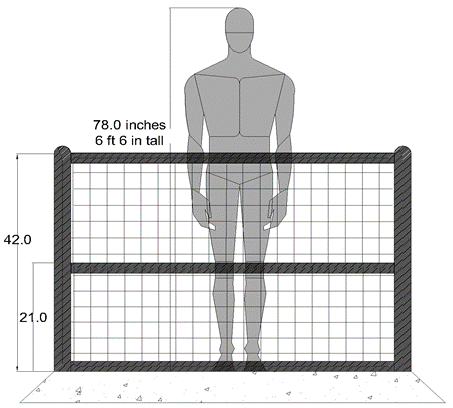
According to National Health Statistics Reports (2018), the average height of American men and women over 20 years old between the years 1999 to 2016 was 5 feet 9 inches (69 inches). Based on the second quartile height data of the US population, the approximate height of the guardrails should not be less than 36 inches. Both of these cases are scaled and visualized in Figure 2 compared to a 6.5 feet tall person. It is obvious that neither of the cases is safe from falling over them. If the CGB concept is applied to 26-inch guardrails, it yields that it can only protect people of approximately 3.83 feet tall, which would be considered a statistical outlier according to U.S Census Bureau, Statistical Abstract of the United States (2011).
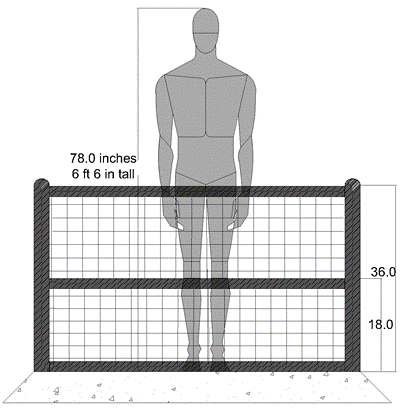
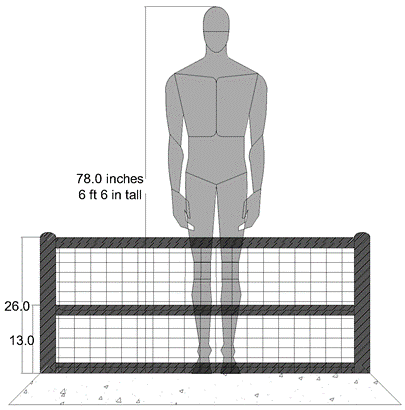
Thus, architects and engineers of sports and concert venues are often given the extremely challenging, and sometimes contradictory design directive of maximizing the number of spectators, optimizing the spectator views, and managing the safety of the whole experience. Upper levels and decks in stadiums are often viewed as a necessary design solution, as they seem to reconcile maximizing the number of spectators, while still maintaining some level of proximity to the action. Larger arenas are often built with tiered seating, and multiple levels, well above the 30” elevation difference specified in the IBC. Hence, guardrails are an integral part of stadium and arena design.
Railing Materials and Guardrail Design Considerations
Because fans can use and abuse rails, it is important to build them from the very beginning to withstand the wear and tear of inappropriate but expected fan behavior. Railing systems can be fabricated using steel, anodized aluminum, cable/wire, glass, concrete, iron, brass, copper, chrome, wood, composite materials, and even PVC and vinyl. Regardless of the type of material used and certain benefits they provide, the primary purpose of most railing is safety.
In a broader classification, there are two primary railing types, which are handrails and guardrails. While handrails are constructed to be grasped and provide a reliable handhold as people travel along their length, guardrails are designed to protect human beings from a wide range of dangers, such as falling over an elevated surface.
Guardrails can be technically described as the barriers having vertical supports spaced at a certain distance, horizontal parts, namely bottom/toe board, mid-rail, and top rail, and infills between these parts. Even though there are many different types and plans of guardrails, Figure 3 demonstrates an example of a standard guardrail plan.
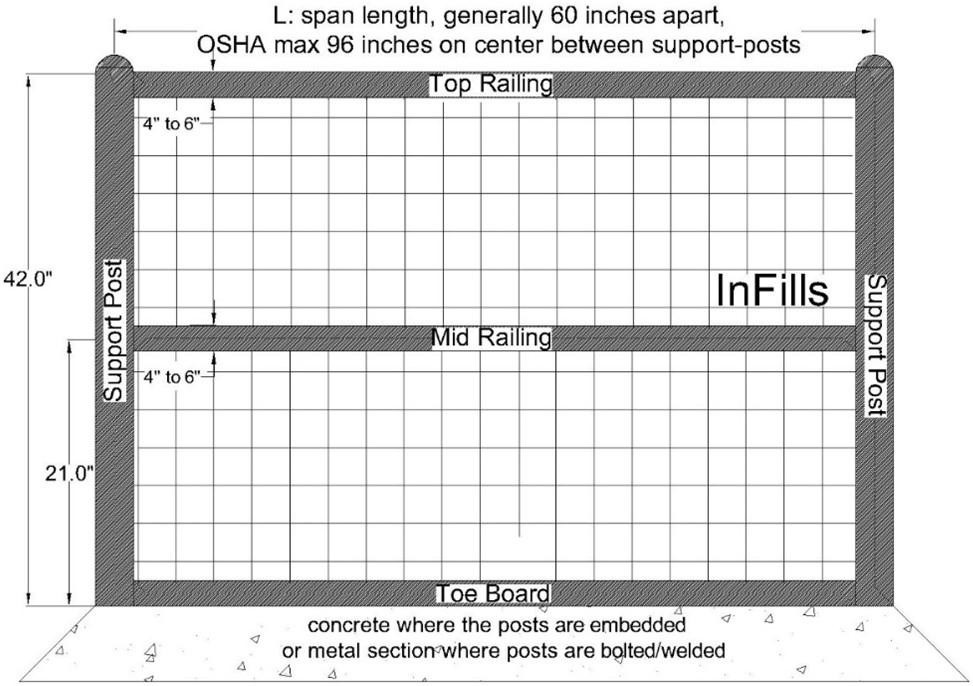
Guardrails mainly consist of 4 main components, which are
- Support posts- vertical load-bearing flexural elements
- Horizontal rails- bottom/toe board, mid and top rails
- Infill/baluster- material filling the space between support posts and horizontal rails
- Connections- embedded/anchored into concrete, bolted/welded into steel frames, or screwed/bolted into wood members
The complete design of guardrail systems includes the design of every single guardrail component properly against loading (structural), height, spacing, and deflection requirements to meet applicable code requirements. Each guardrail system is designed to resist a certain load at a specific height and uniform post spacing without showing excessive deformations. This means that all the component parts of the railing system need to function properly together in order to protect fans from the pressure they can exert on the rails when many fans are leaning against the rail.
Both IBC and most of the local codes refer to the American Society of Civil Engineers (ASCE) Minimum Design Loads and Associated Criteria for Buildings and Other Structures- ASCE7 section 4.5.1 for the load requirements on the guards, which states that the guards shall be designed to resist a linear load of 50 pounds per linear foot (plf) applied horizontally to the top rail or a single concentrated load of 200 lb. applied in any direction at any point on the top rail and to transfer the load through the supports to produce the maximum load impact on the element being considered (ASCE, 2016). These loads are representing either the force applied by a tightly gathered group of people leaning on a railing system in case of uniform loading or a single person pressing against or an object pushing the rail in case of concentrated loading. Figure 4 illustrates the scenarios and loading conditions for both concentrated and uniformly distributed load conditions. It is important to note that the most critical loading happens when the top rail is loaded horizontally, which results in the maximum bending moment on the posts.
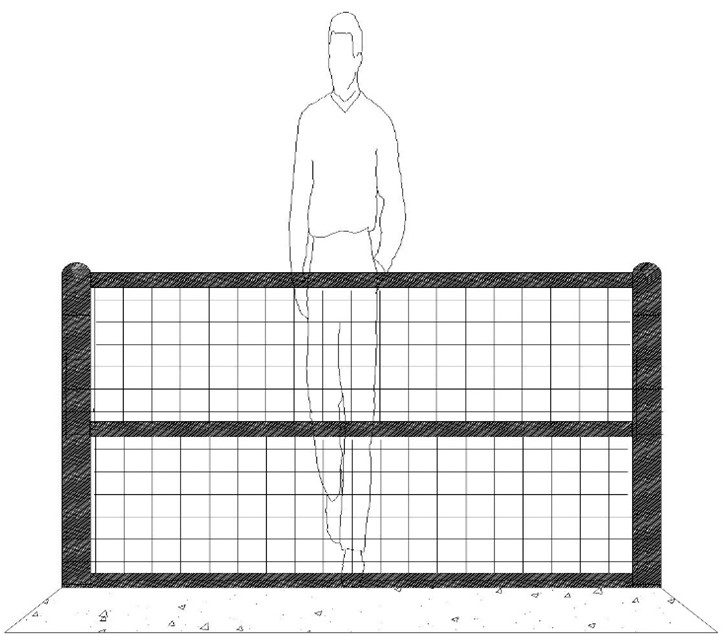
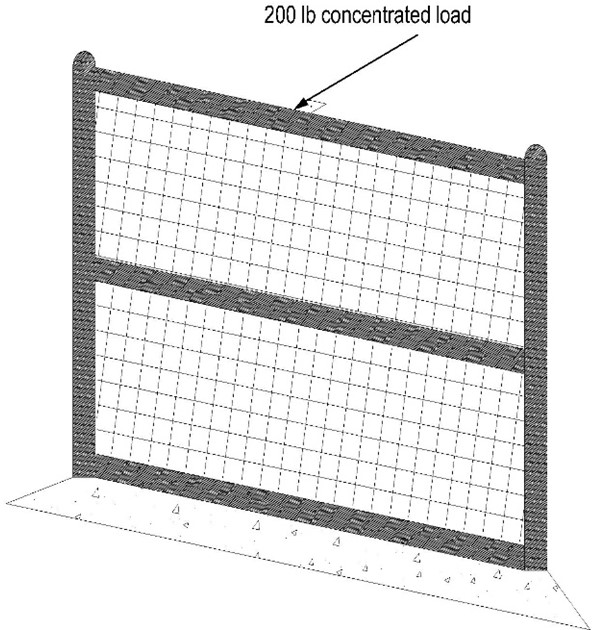
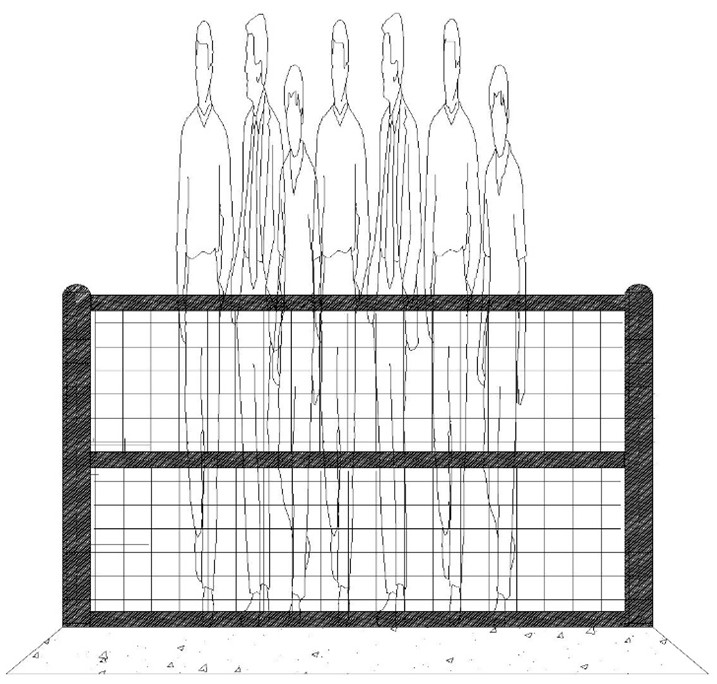
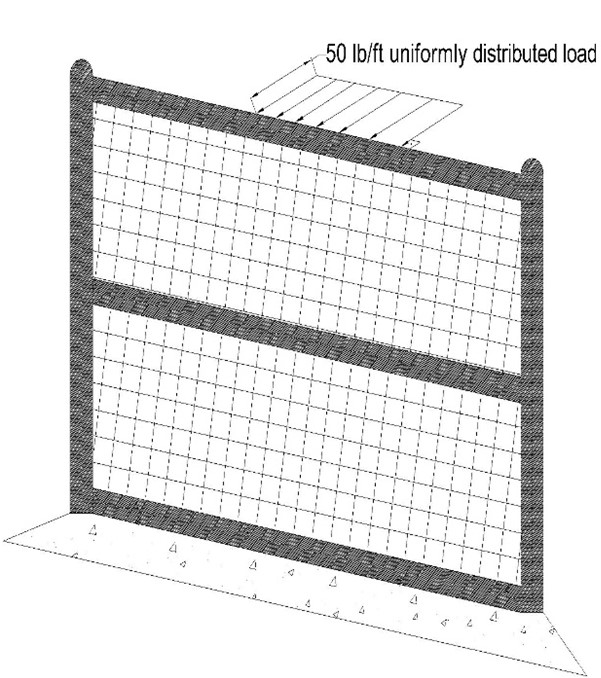
Figure 4: Concentrated and uniformly distributed loading cases
Structural design of guardrails does not only include the design of guardrail members for the strength requirements, but it also covers their serviceability requirements. In order to satisfy the serviceability requirements, guardrail members should not deflect or deform excessively under the applied loads. This means that if twenty people are leaning against the rail, as an example, the rail would not move or change shape. There will always be deflection, but it just should be within the limits.
The discussion so far might seem complicated and outside the purview of most venue executives. However, a stadium/arena manager needs to know railing height, condition, attachment points, and related variables to make sure the railing system can do its job- protect fans. Stadium/arena managers should have a rough idea and visually monitor railing components. If there appears anything unusual, such as rust or crumbling cement, professionals should be contacted to ensure the railing system is not compromised.
Risk Management Strategies
If there is an issue with the railing height or railing integrity at various sport/entertainment venues, then there needs to be possible solutions to consider. With input from local code officials, design professionals, and industry representatives, the International Code Council updates the International Building Code, and reviews any proposed design changes on a 3-year cycle. Through this process, the IBC could mandate stricter requirements for guardrails. This would entail a concentrated educational campaign to educate those working with the IBC about the serious injuries and deaths and that the 26-inch line of sight exception should be changed. The American Society of Theater Consultants (ASTC) suggested in 2016 that there are fundamental differences between the behaviors of sporting event audiences, and those of the theatre, such that they should have separate Building Code requirements.
Another option is for architects and builders to work with teams or venue owners to examine the proposed/existing design and develop designs that will hopefully make venues safer. In the United Kingdom, the Sports Ground Safety Authority relies on the collective and collaborative knowledge of engineers and architects, police, emergency planners and facilities maintenance professionals (SGSA 2021), advocates a railing height of 31.5” (800mm) for sight constrained guards. Further accommodations could be made by modifying the pitch of stairs, or tiered seating installations in public venues, such that the seating areas are further removed from elevation drops where guard areas become necessary. This can be accomplished by adding horizontal walking surface between the seating and the guardrails or providing an access aisle behind the first row of seating.
Other suggestions include: a risk management strategy to help make lower railing safer through using glass or clear plastic above the railing height to help preserve the sight line, but also to provide some added protection or utilizing safety netting. Netting is utilized at TopGolf venues to protect fans from injury after falling over an elevated driving platform. While there is no rail, there are nets used to protect people from falling.
There is no one correct solution but having a hard target railing height based on science and how people interact with the venue will be a significant step forward. On the other hand, while changes might be considered, it is important to identify strategies to help make railings less dangerous. Venues could provide additional warnings to fans sitting near the front rows and those directly underneath railing sections that there are potential risks. Railings can be painted a distinct color so they stand out. Signs can be posted discouraging people from dancing, selfies, leaning over, and other possibly dangerous behavior near the railing. This is especially important when many people can congregate near or against railing and such a mass of bodies can cause railing or its anchoring system to fail under pressure.
Dr. Gil Fried is a sport management professor and Chair of the Administration & Law Department. Drs. Kocak and Grant are both Construction Management professors in the Administration & Law Department at the University of West Florida.
…

